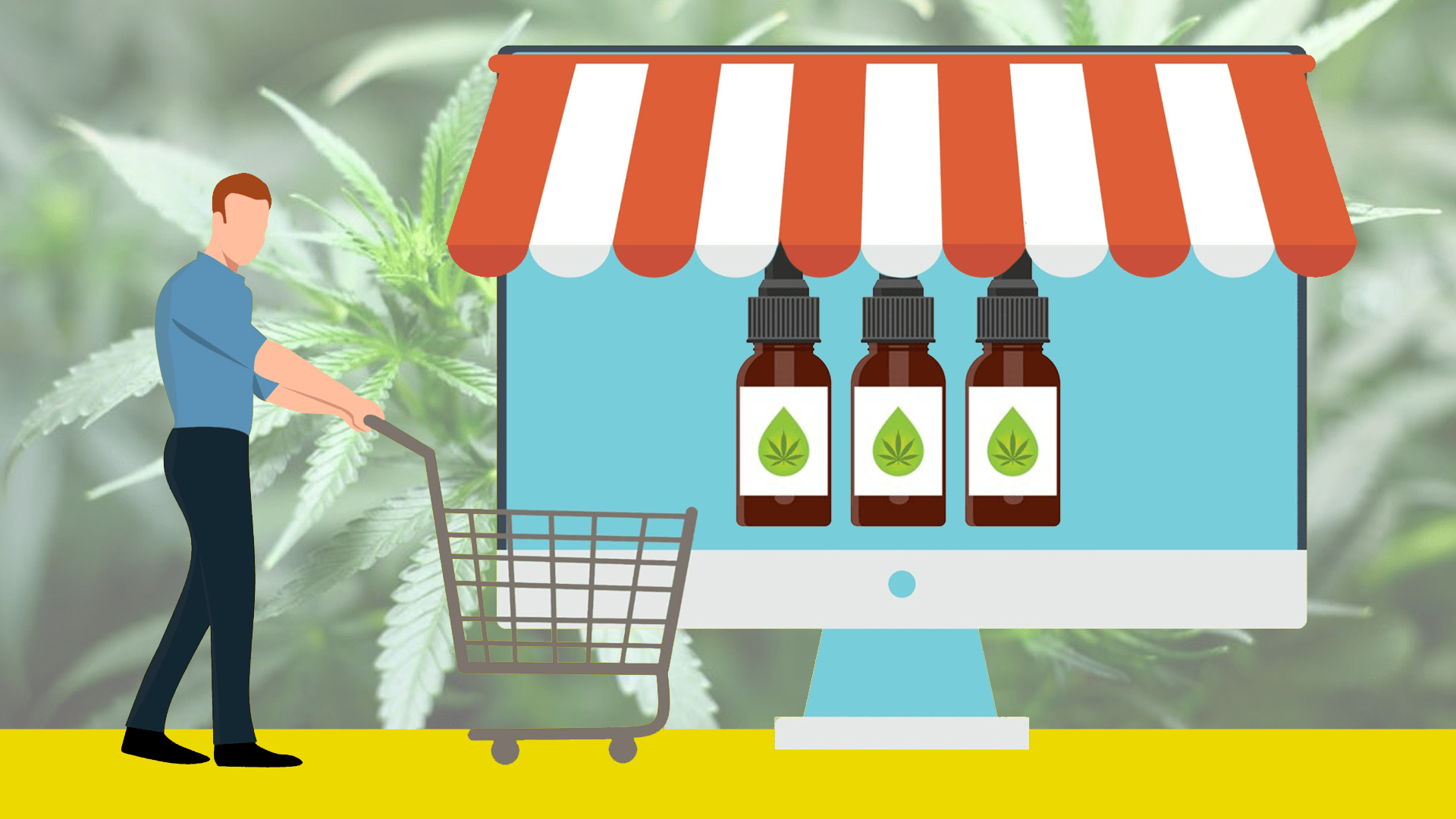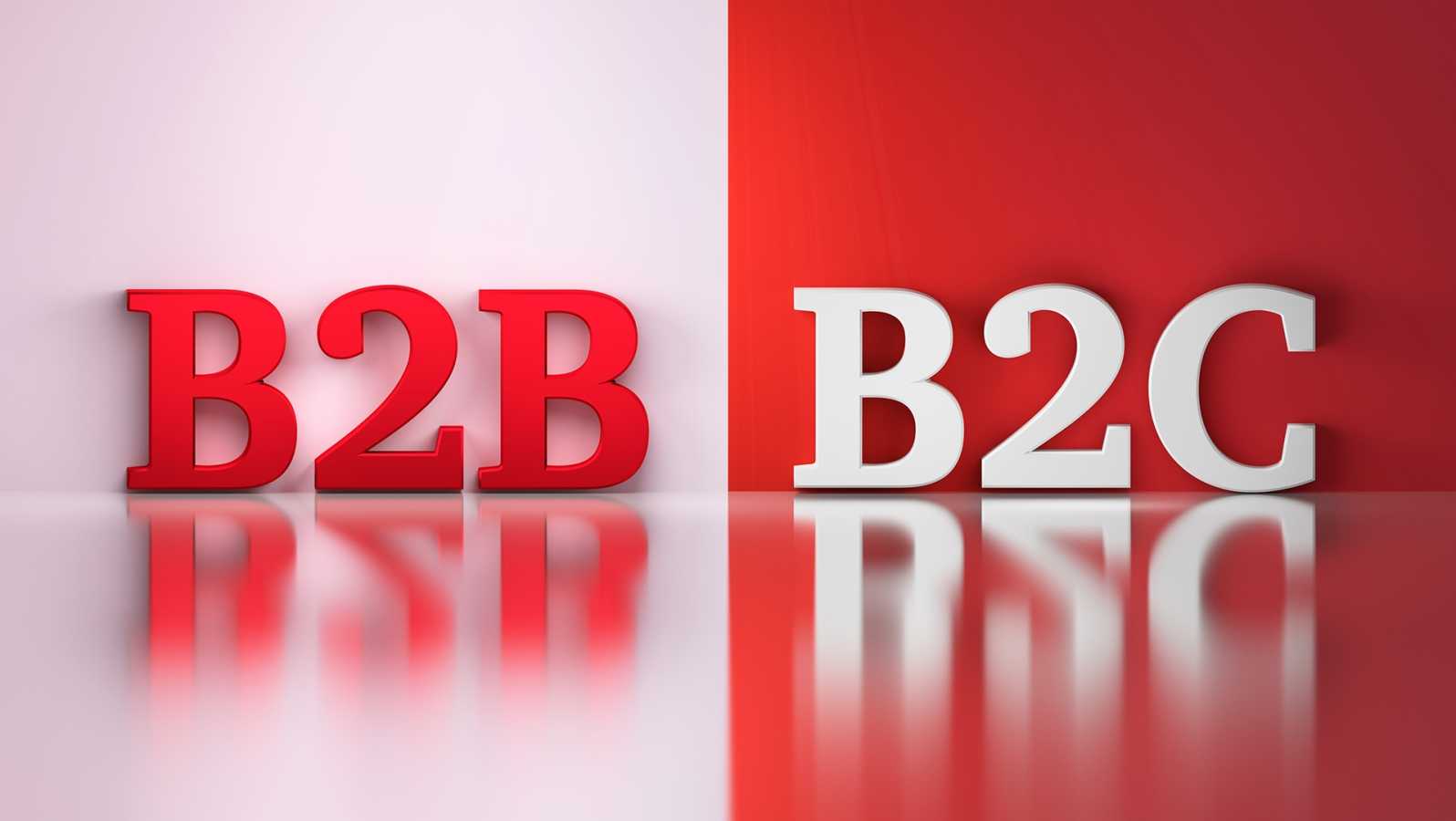eCommerce businesses always need to come up with new ways to expand. But with so much competition in this space, this isn’t always something that’s easy to do.
How are you finding new customers? What strategies are you using to reach a wider audience?
Right now, your existing eCommerce marketing tactics may or may not be effective. Sometimes you need to take a different approach to reach your goals.
Try some marketing strategies that are different from traditional methods. That’s why your eCommerce brand should consider growth hacking.
What is growth hacking?
It’s a relatively new marketing concept. The phrase was first coined less than a decade ago in 2010 by Sean Ellis.
By definition, growth hacking is the process of swift or rapid experimentation across all segments of the marketing funnel.
Growth hacking focuses on areas like sales, product development, and any other area of a business that will lead to growth. One of the focal points of growth hacking is that marketers who take this approach implement low-cost marketing strategies compared to traditional methods.
That’s why it’s so popular for startup companies that don’t have as much of a disposable marketing budget.
Instead of using paid advertisements on television, radio, and newspapers, growth hackers leverage targeted ads and viral marketing through channels like social media.
With startup companies, growth hackers attempt to expand their company at a rapid rate during the beginning stages of product development and launches. But growth hacking can be used by any business, regardless of its age.
Here’s a look at the growth hacking marketing funnel, which I briefly mentioned earlier.
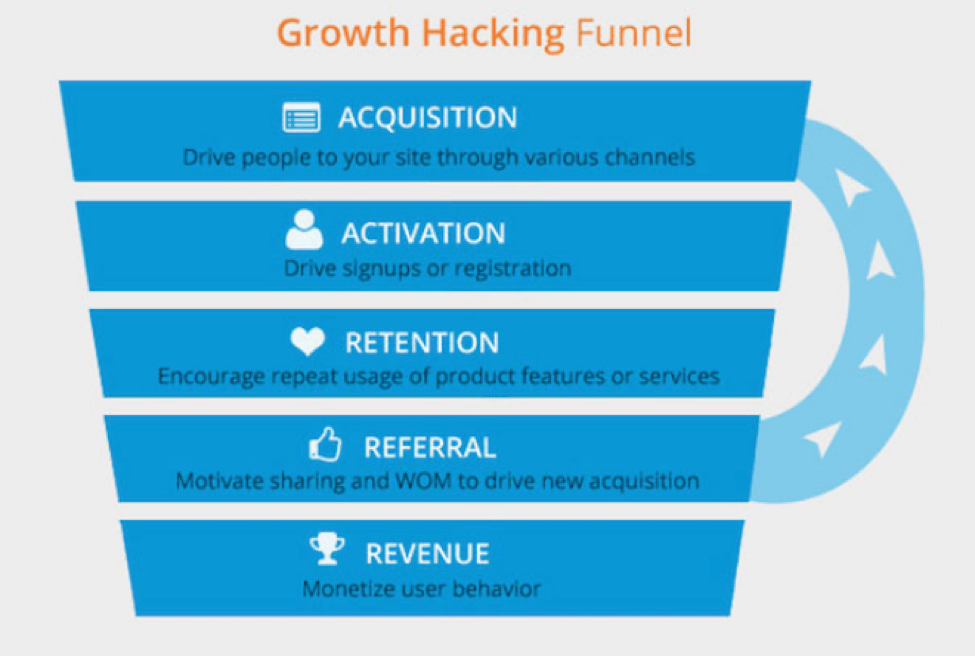
As you can see, it’s definitely not limited to startup companies only. Even if your eCommerce brand has been in business for ten years, you can still apply growth hacking strategies today.
So, what’s a low-cost and non-traditional growth hacking strategy that your eCommerce brand can implement for rapid expansion?
Influencer marketing.
If you read my guide on Internet marketing and how it works, you’ve already been briefly introduced to this subject.
For those of you who aren’t familiar with this type of marketing strategy, I’ll explain everything you need to know about it in this guide. Even if you’ve tried influencer marketing in the past, there is always room for improvement.
This guide is beneficial for any eCommerce business interested in growth hacking and influencer marketing. Here’s what you need to know.
Influencer Marketing Basics
Let’s make sure we’re all on the same page before we go any further.
Influencer marketing is a strategy that focuses on finding people with a large following and influence over a larger group of people. Basically, you want to identify individuals that speak to your target audience.
Then, these influencers will promote content that’s directly related to your brand. Social media is one of the best distribution channels for this type of strategy.
Here’s a simple example. Let’s say your company sells sports equipment.
You could work with a well-known athlete and have them promote your products on their social media profiles. People who follow this athlete are likely to be interested in your brand, but they may not know about it until an influencer promotes it.
Why should you try influencer marketing as a growth hacking strategy?
For starters, 94% of marketers say that influencer marketing is effective for their businesses.
With such a high success rate, it’s a safe bet that this approach will work for your eCommerce company as well, as long as you take the right approach.
Types of Influencers
There are so many different types of influencers out there.
Here’s a visual representation to give you an idea of the options at your disposal.
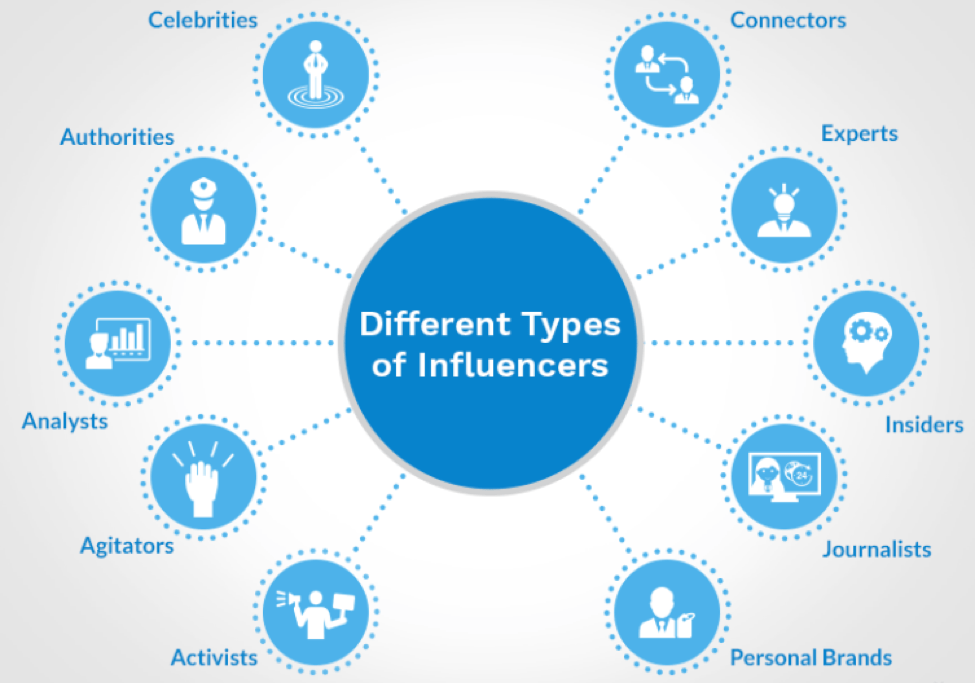
So before you go out and implement an influencer marketing strategy for your eCommerce brand, it’s important for you to decide what type of influencer you want to work with.
This could depend on a wide range of factors. You’ve got to understand your industry and recognize your target market.
For example, YouTube campaigns influence 22.8% of men compared to just 13.9% of women when it comes to buying decisions.
Furthermore, when it comes to consumer electronics products, 34.4% of men are influenced by blogs. Only 15.4% of women say that blogs influence their purchasing decision for this type of product.
Yes, these examples are extremely specific. So you need to do your research about your own industry and target market before you proceed.
Influencers can also be segmented based on their reach.
Depending on who you ask, there are different names for these categories and the number of followers vary slightly. But I think it’s best to separate influencers into three main categories.
- Micro influencers
- Macro influencers
- Celebrities
Some people include categories for middle influencers or mega influencers as well, but I think that just over complicates things. For our purposes, we’ll stick to these three.
Micro Influencers
Micro influencers can be anyone who has between 1,000 and 100k followers on social media.
Often times, these are just average people who happen to have lots of followers because of the content that they post. But they work normal jobs and have their social media page as more of a side project.
These are my favorite types of influencers to work with. For starters, they will be your cheapest option, but we’ll talk more about the cost of influencers shortly.
Micro influencers are great because they have the most authentic engagement with their audience. People can relate to micro influencers on a more personal level.
The average Joe will have more in common with a micro influencer than a celebrity like Kim Kardashian or Kanye West.
Plus, micro influencers have more than 22 times more buying conversions compared to macro influencers and celebrities.
Furthermore, 82% of consumers say they are very likely to follow recommendations made by micro influencers. 94% of consumers say that micro influencers are highly knowledgeable.
Macro Influencers
Macro influencers have more than 100k – 500k followers. Even people with 700k or 800k followers can fall within the macro influencer category.
While macro influencers may not necessarily be celebrities, they usually have a much more established personal brand name than micro influencers.
For the most part, these people will leverage their social following as a career move. They put more effort into monetizing their name and social profiles and may only have a part-time job to subsidize their income.
With more followers, an endorsement from a macro influencer will obviously expose your eCommerce brand to a wider audience.
That’s why influencer marketing is the fastest growing method for customer acquisition online.
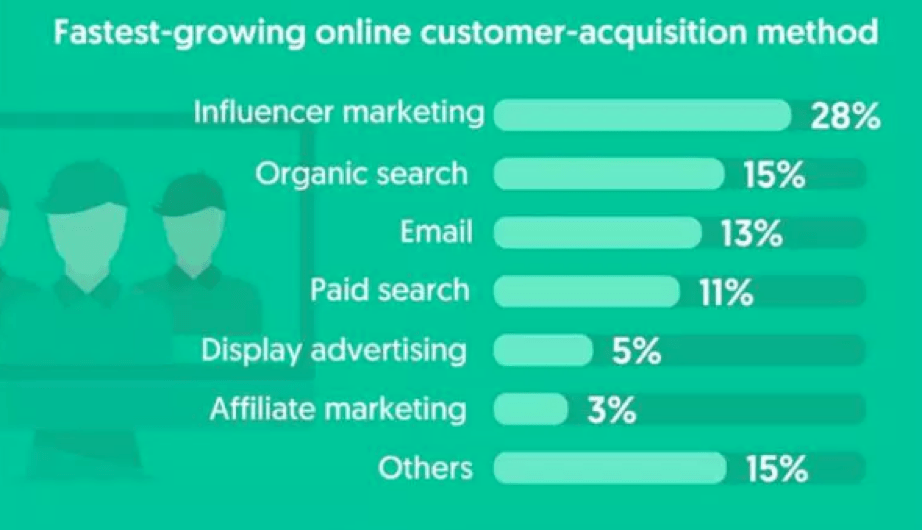
However, the more followers someone has, the lower their engagement metrics will be.
Plus, consumers may not trust a macro influencer as much as they would trust a micro influencer. So just take this into consideration before you proceed.
Celebrities
Using a celebrity in as part of your influencer marketing campaigns probably isn’t reasonable for most eCommerce businesses.
Just based on the cost alone, celebrity endorsements won’t even fall into the growth hacking strategy.
People with followers of 1 million or more can be considered celebrities. These are people who are musicians, actors, and athletes.
I won’t spend too much time talking about celebrity influencers since it’s not going to be relevant for most of you.
How Much Does Influencer Marketing Cost?
Now that you have a basic understanding of what influencer marketing is and how it works, it’s time to dive deeper into the specifics. How much is this going to cost you?
Well, like most things you buy, it depends.
There isn’t one set price for buying a car, sneakers, or plane ticket. There isn’t one set price for influencer marketing either.
One of the first things you’ve got to take into consideration is the type of influencer you’re going to work with. The more followers they have, the more money it will cost you.
For example, if you want a celebrity like Kylie Jenner to post about your brand on Instagram, it’s going to cost you $1 million.
I think it’s safe to assume you don’t want to spend that much on a single Instagram post. But fortunately, you don’t have to.
For growth hacking purposes, you’re going to want to stick with the most cost-effective strategies, which is why I recommend sticking with micro influencers.
Here’s a rough idea of how much it will cost you for micro influencers on various social platforms.
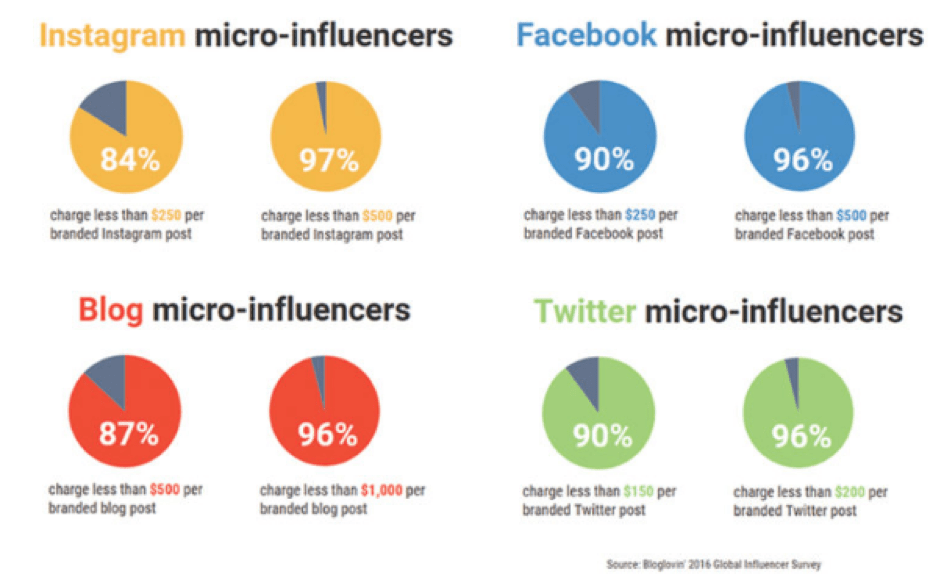
On social media, it’s safe to say that you can budget for around $250 to $500 at most for posts from micro influencers.
But there are a few things you need to take into consideration.
Based on how we segmented influencers into three categories, someone with 5,000 followers and 90k followers both fall into the micro influencer category. However, you can’t expect to pay those people the same amount. Obviously, someone with 90k followers can charge more.
The type of content they share will also impact the price.
For example, if they are going to upload a video to their Facebook timeline or YouTube channel about your eCommerce brand, it will cost more than a post on their Instagram story, which will just disappear after 24 hours.
Since influencer marketing is so new, there are ways for you to bargain with these influencers.
As we continue, I’ll show you some ways to negotiate their compensation for less than you initially thought it would cost.
Finding the Right Influencers for Your eCommerce Company
Now you need to make sure that you find an influencer that’s going to give your eCommerce company the results that you’re looking for.
It’s a common misconception that your influencers need to fit the description of your target audience. That’s not necessarily true. Allow me to explain.
Let’s say your eCommerce company sells men’s swimwear. Your target market is men between the ages of 24 and 35.
So you find a male influencer living in southern California, who is a 29-year-old surfer with 30k followers. Perfect, right?
Not necessarily. If 85% of his followers are female, anything he posts about your brand on social media won’t reach your target audience.
There are tools to help you find an influencer that can reach your target audience, but I’ll talk about that in greater detail shortly.
If you want to save some money, you can go through your followers manually. By looking for people who already follow your brand, it’s safe to assume they are interested in your products.
You can also sort through tags and hashtags related to your company. Find people who are already posting about your eCommerce products.
These approaches may take more work, but it can definitely save you some money.
You may come across people with lots of followers who are already posting about your brand for free. Reach out to them. Try to work out a deal where they continue to promote your products in exchange for free gear, as opposed to monetary compensation.
No matter which strategy you use to find an influencer, you need to make sure that they aren’t going to damage your brand reputation.
Stay away from people who post about controversial topics like politics, race, and religion. You won’t want to be involved with anything like that.
Make sure their previous posts don’t conflict with your brand image. For example, let’s say your eCommerce brand sells cooking products for vegans. It wouldn’t make sense to use an influencer that has hunting pictures on their profile.
Tools for Finding and Managing Influencers
If you’re ready to pay a little bit more than just offering free stuff, you should take advantage of platforms that connect you with prospective influencers.
Try using a tool like Klear as a starting point.
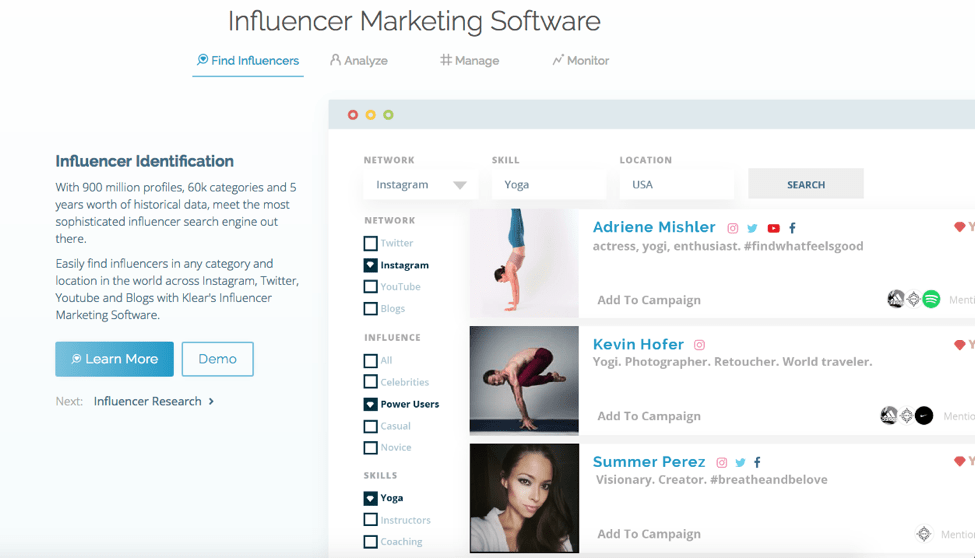
This software makes it easy for you to find an influencer based on how many followers they have and the social network that they use.
Once you click on an influencer’s profile, you’ll see analytics about their audience. This information will tell you if their followers fit your target market.
If you decide to proceed with influencers on this platform, it’s easy for you to manage your relationship by communicating with them directly through the Klear software.
You can manage all of your influencers from one place, so you can stay organized.
Klear also gives you data-driven analytics about the results of each influencer marketing campaign that you run. This will give you a better understanding of which influencers are having the most positive impact on your business.
In addition to Klear, these are some other top platforms for you to consider.
- Buzzsumo
- BuzzStream
- GroupHigh
I’m confident that you’ll be able to find what you’re looking for on one or more of these networks.
Measure the Results of Your Influencer Marketing Campaigns
Like every other marketing campaign you run, it’s important to understand if your strategy is actually working.
You don’t want to dump money on marketing tactics that are ineffective.
Even though growth hacking strategies like influencer marketing are generally inexpensive, every dollar counts. So don’t take this lightly.
These are the top metrics that measure the success of influencer campaigns.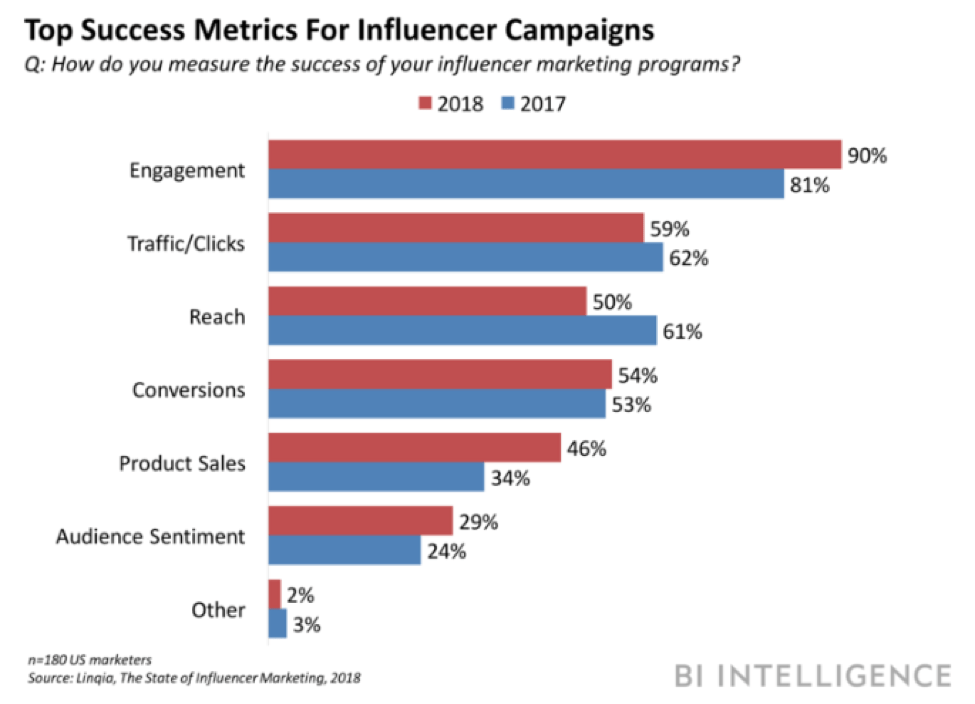
If some of your influencers are having much higher results than others, it may be time to cut ties with those low-performing influencers and double down on the ones with the highest engagement rates.
In addition to using these metrics as a benchmark, there are other ways to track the success of our influencer campaigns.
Getting an influencer to post about your brand is only the first step. Then, you want their followers to have an actionable response to the post.
Ultimately, you want them to visit your site and buy something. Sure, you’ll settle for them signing up for your email list or following your brand on social media, but sales are the ultimate goal.
That’s why you need to understand the importance of conversion rate optimization for eCommerce stores.
If consumers are just hearing about your brand for the first time, they may not be interested in buying something just based off of an influencer recommendation. So you need to find ways to give them an added incentive.
Take a look at how Thompson Tee leveraged their relationship with James Tollefson.

With more than 27k followers, James is considered a micro influencer.
To give James’ audience a reason to try this product, Thompson Tee gave James a promo code to put in his profile.
This strategy kills two birds with one stone.
First, it gives new customers an incentive to buy. But second, it gives them a way to track the success of their campaign.
If a large percentage of sales come from that promo code, the company will know that they can continue working with this influencer in the future.
It’s also worth noting the hashtag used in this post, #thompsonteepartner. That’s how James discloses his relationship with this brand, but we’ll talk more about this later.
Dedicate a Landing Page for Influencers
In addition to using third-party platforms and social media networks to leverage your relationships with social influencers, you should also have a specific landing page for this content on your website.
So if people navigate to your site organically, your relationships with these influencers add credibility to your name.
Here’s an example of this strategy used by Lululemon.
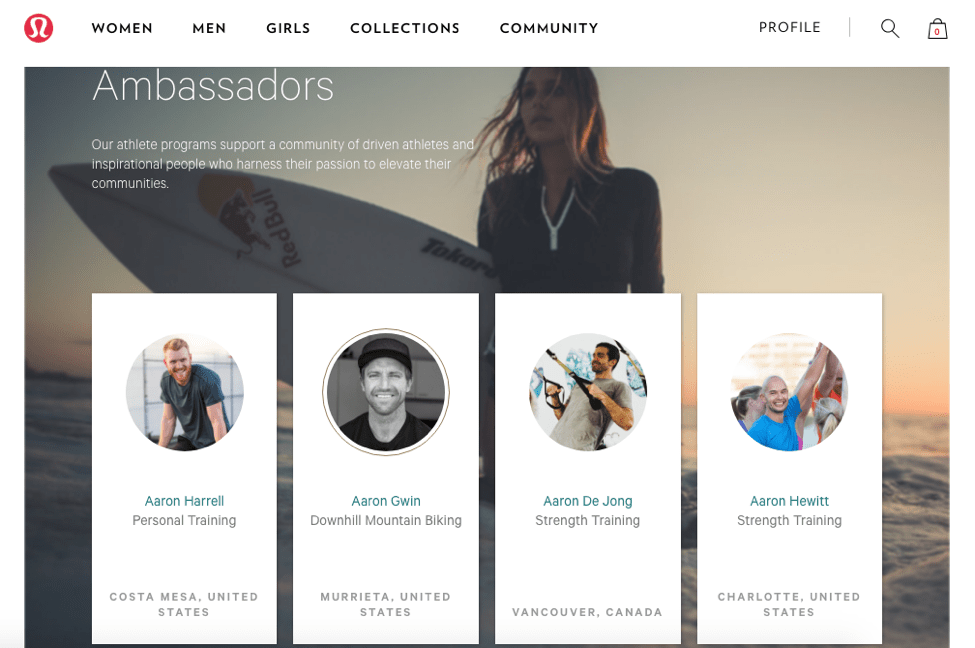
If people haven’t heard of this brand before, the influencers listed on their ambassador page can make consumers feel comfortable about buying from a credible source.
Credibility is extremely important for online retailers, especially if you want to avoid eCommerce chargebacks.
FTC Compliance
All of your influencer campaigns must be compliant with the Federal Trade Commission guidelines.
As I briefly mentioned earlier, with the Thompson Tee hashtag, influencers need to fully disclose their relationships with brands.
You can’t assume that people know about these relationships. So the sponsorship disclosure needs to be clear, obvious, and hard to miss.
Avoid ambiguous tags such as #ambassador or #collab. Instead, tell your influencers to come right out and use a hashtag like #ad in the post instead.
Here’s a great example of how professional surfer, Anastasia Ashley, used a hashtag to comply with FTC regulations in her collaboration with Calia by Carrie.
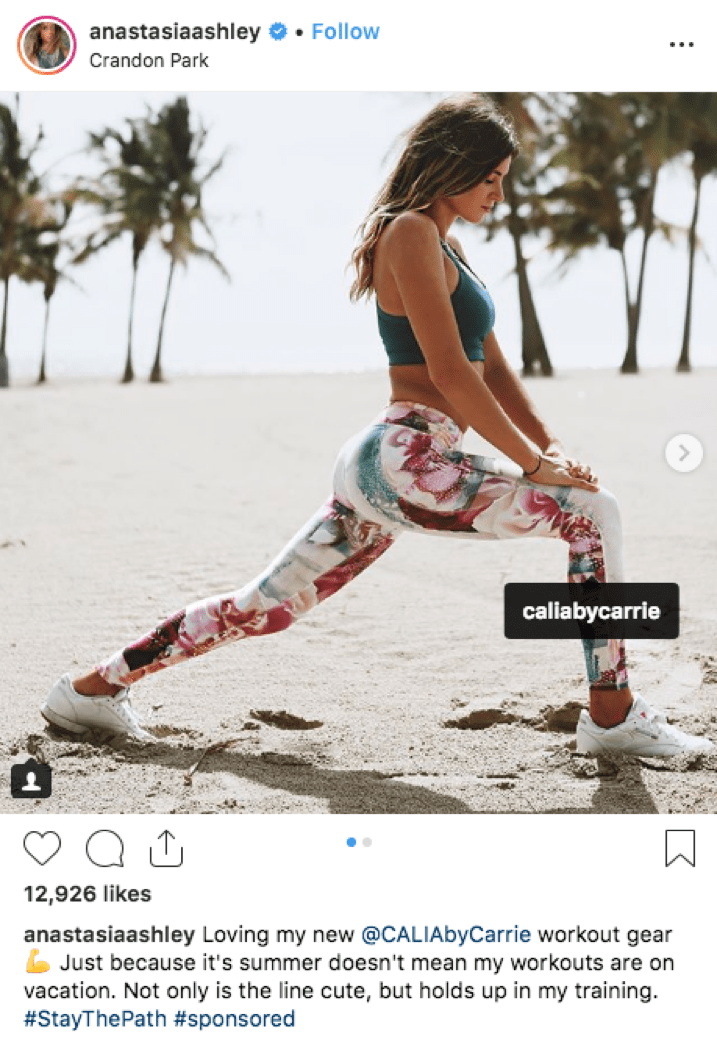
As you can see, the post is clearly tagged as #sponsored.
This won’t deceive her audience into thinking she’s promoting this brand without getting compensation for it.
Encourage Online Reviews
Influencer marketing goes beyond just paying people with lots of followers to promote your brand.
Consumers are also influenced by other factors.
81% of people conduct research online about products before they finalize a purchase. That’s why customer reviews are so important.
72% of consumers say they trust online reviews just as much as a personal recommendation.
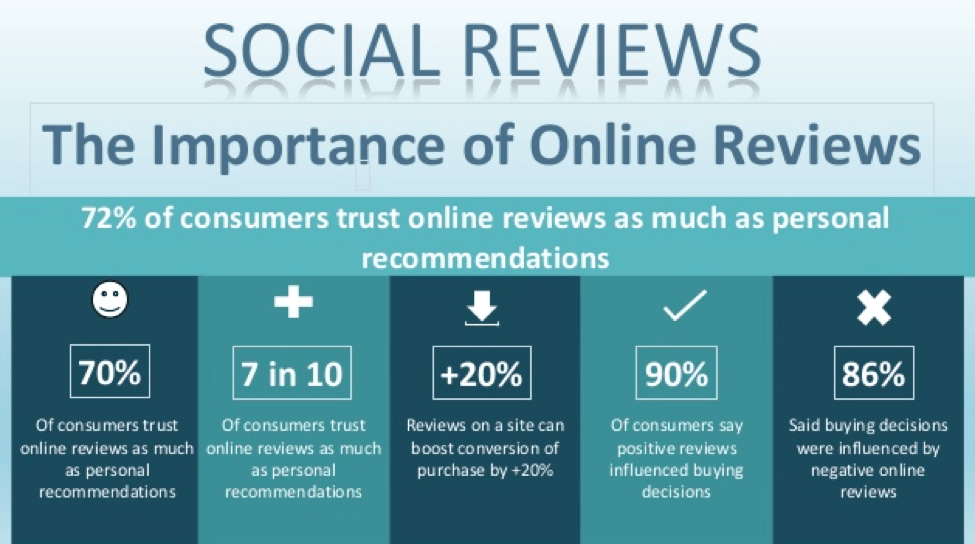
So finding ways to encourage these reviews needs to be part of your growth hacking strategy.
I also recommend using testimonials from influencers on your website to improve your credibility and encourage sales.
Apply Influencer Marketing to Your Growth Hacking Strategy
If you have an eCommerce company and you’re looking for new ways to expand your reach, I recommend taking a growth hacking approach.
Leverage influencer marketing tactics to target prospective customers on social media and other platforms where influencers have an active presence and large following.
Understand the type of influencer you want to work with and have an idea for how much money you’re willing to spend on these campaigns.
You can take advantage of tools that connect you with influencers as well.
Don’t forget to use your website to showcase reviews, testimonials, and relevant information about your relationships with influencers. This will add credibility to your brand name.
It’s also important to make sure that all of your influencer campaigns are FTC complaint.
If you need further assistance with growth hacking and influencer marketing, please don’t hesitate to contact us here at Optimum7. We would be happy to help.



